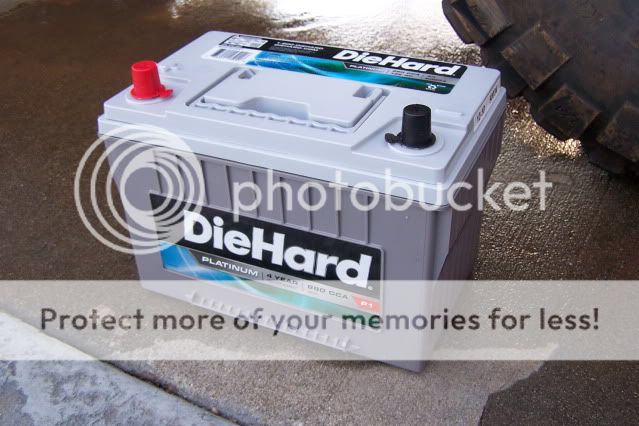fyrfytr1717
NAXJA Forum User
- Location
- Turlock, CA
First off my '99 has 94K on the clock, 4.0 with an AW4. Yesterday I went to start it up to follow my wife to Carmax so we could trade in her Patriot. I put the key in and turned it and got nothing. Nada. Zip. No beeps, no lights, no noises, just dead.
I put a DVM on the battery and it showed 0 volts. I hooked up a spare Optima I have laying around with some jumper cables and the Jeep came back to life. Tried to start it but the spare battery didn't seem to have enough juice.
Not believing the battery could actually be at 0V, I disconnected my battery cables (all of which were replaced about a year ago) and put the DVM on the battery again. Now it showed 12.5V. Hooked the cables back up again, 0V. Took them off again, 12.5V. Put them on, 0V. Guess I'm a slow learner...
Next I hooked it up to my wife's car for a jump. Using the old feather the throttle while cranking the engine trick I got it to start. As I let off the throttle, it sputtered and died. Fired it up again, ran it for a bit at high RPMs, and finally got it to idle on its own. When I dropped it into gear, it tried to die on me again. I started driving it like I had a dead battery (dropped into neutral around slow corners and at stops so I could throttle up to keep it from dying) and the voltage gauge on the dash would drop each time I started to slow down.
About 1/2 mile into my drive, the voltage gauge suddenly pegged to the max side of the scale and my Check Gauges light came on. I cruised along for just a bit and then decided it was time to pull over. I tried to flash my high beams at my wife to let her know I was pulling over and as soon as I pulled the high beam switch the Jeep completely died, voltage gauge still pegged at max even though everything else was completely dead.
Fiddled around with it for a bit on the side of the road and got the same 12.5V and 0V readings off the battery. Smelled a bit of an electrical smell. I started pulling leads off one by one to see if I had a short or a ground issue with one of my mains. In the process I discovered that if either the + or - was completely disconnected from the battery I once again got a reading, though I seem to recall it was only about 10.5V.
I was starting to suspect a failing alternator so I pulled the ANL fuse connecting it to the PDC and tried to start the engine. Still nothing. In a last ditch effort I tried jumping it off my wife's car again with the fuse still pulled. It started up and I limped it home and parked it in the driveway. Left it for the day while we sold the Patriot (which interestingly enough had an intermittent no start issue) and I did not get a chance to play with it until today, two days later.
Checked the battery voltage and it was normal. Replaced the ANL fuse and voltage was still normal. Got in, fired right up. All voltage readings normal. 12.5V with the ignition off, 13.8V with the motor running. Tried all switches, lights, etc. and could not get it to even stutter a little. Sprayed the alternator with the hose and a little muddy water came out, likely due to the snow/mud trip I went on last week. Other possible contributing factors are that I also gave the engine compartment a pretty good rinsing last week, and that was in the middle of a week of pretty heavy rain. I had driven at least 100 trouble free miles between the time all of the above occurred and the time it died. Weather has been dry the last few days. So what the heck happened? I think the Patriot did it, what do you think?...
I put a DVM on the battery and it showed 0 volts. I hooked up a spare Optima I have laying around with some jumper cables and the Jeep came back to life. Tried to start it but the spare battery didn't seem to have enough juice.
Not believing the battery could actually be at 0V, I disconnected my battery cables (all of which were replaced about a year ago) and put the DVM on the battery again. Now it showed 12.5V. Hooked the cables back up again, 0V. Took them off again, 12.5V. Put them on, 0V. Guess I'm a slow learner...
Next I hooked it up to my wife's car for a jump. Using the old feather the throttle while cranking the engine trick I got it to start. As I let off the throttle, it sputtered and died. Fired it up again, ran it for a bit at high RPMs, and finally got it to idle on its own. When I dropped it into gear, it tried to die on me again. I started driving it like I had a dead battery (dropped into neutral around slow corners and at stops so I could throttle up to keep it from dying) and the voltage gauge on the dash would drop each time I started to slow down.
About 1/2 mile into my drive, the voltage gauge suddenly pegged to the max side of the scale and my Check Gauges light came on. I cruised along for just a bit and then decided it was time to pull over. I tried to flash my high beams at my wife to let her know I was pulling over and as soon as I pulled the high beam switch the Jeep completely died, voltage gauge still pegged at max even though everything else was completely dead.
Fiddled around with it for a bit on the side of the road and got the same 12.5V and 0V readings off the battery. Smelled a bit of an electrical smell. I started pulling leads off one by one to see if I had a short or a ground issue with one of my mains. In the process I discovered that if either the + or - was completely disconnected from the battery I once again got a reading, though I seem to recall it was only about 10.5V.
I was starting to suspect a failing alternator so I pulled the ANL fuse connecting it to the PDC and tried to start the engine. Still nothing. In a last ditch effort I tried jumping it off my wife's car again with the fuse still pulled. It started up and I limped it home and parked it in the driveway. Left it for the day while we sold the Patriot (which interestingly enough had an intermittent no start issue) and I did not get a chance to play with it until today, two days later.
Checked the battery voltage and it was normal. Replaced the ANL fuse and voltage was still normal. Got in, fired right up. All voltage readings normal. 12.5V with the ignition off, 13.8V with the motor running. Tried all switches, lights, etc. and could not get it to even stutter a little. Sprayed the alternator with the hose and a little muddy water came out, likely due to the snow/mud trip I went on last week. Other possible contributing factors are that I also gave the engine compartment a pretty good rinsing last week, and that was in the middle of a week of pretty heavy rain. I had driven at least 100 trouble free miles between the time all of the above occurred and the time it died. Weather has been dry the last few days. So what the heck happened? I think the Patriot did it, what do you think?...






